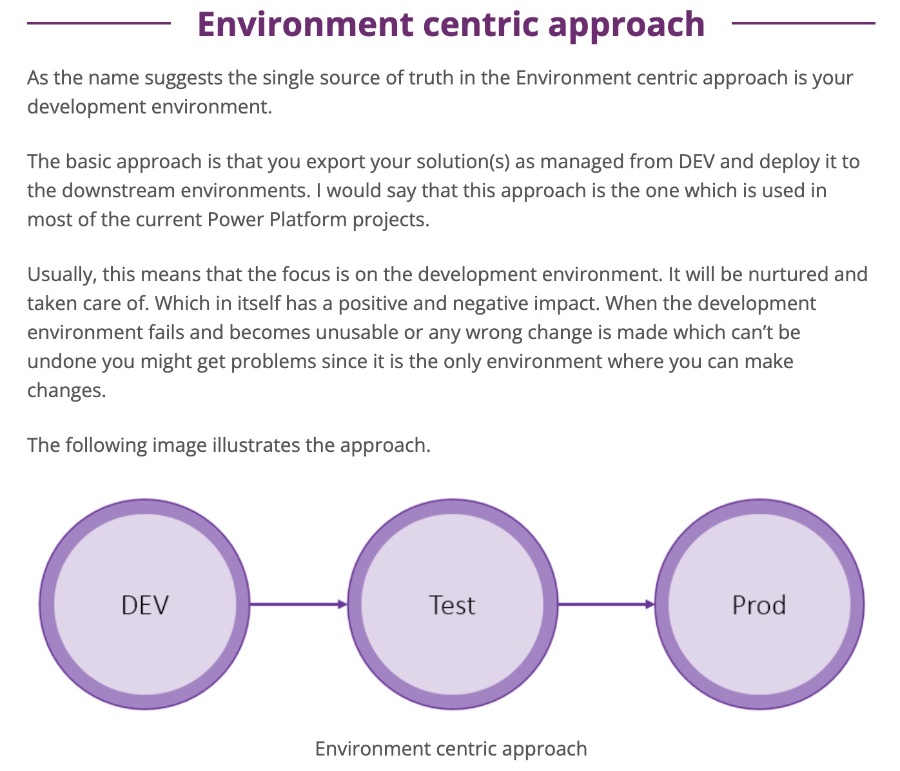
ALM Approaches Compared: Source Code vs. Environment
Explore ALM Strategies: Environment vs Source Code Centric Approaches
Key insights

- Environment-centric ALM relies on the development environment as the single source of truth, focusing on nurturing and care but risking loss or corruption.
- The Environment-centric approach is easy to set up and manage initially, making it popular in many Power Platform projects, despite its vulnerability to development environment issues.
- In a Source code-centric ALM, the repository or source code acts as the single source of truth, emphasizing automation and minimizing dependency on specific environments.
- The Source code-centric approach facilitates advanced ALM practices, enables easy recovery of development environments, and supports branching for development flexibility.
- A Combined approach blends benefits of both, maintaining an environment-centric methodology but allowing recovery via an unpacked version in the repository.
Exploring ALM Approaches: Environment vs. Source Code Centric
Application Lifecycle Management (ALM) stands as a pivotal framework in the realm of software development and deployment, guiding teams in managing the entire lifecycle of an application from conception to retirement. Among the diverse methodologies adopted for ALM, two distinct approaches have emerged: Environment-centric and Source code-centric.
The Environment centric approach focuses on the development environment as the primary source of truth. Solutions are exported as managed from the development stage and deployed to downstream environments. This method is most common in Power Platform projects, emphasizing the nurturing and care of the development environment.
- Easy to set up and manage until a specific size.
- Natural feeling, especially in the early stages of a project.
- Can lead to problems if the development environment fails or becomes unusable.
The former places the development environment at the heart of its strategy, focusing on direct management and transition of solutions across different stages. This method is relatively easy to implement but susceptible to significant risks if the development environment is compromised. Conversely, the Source code-centric approach centralizes the repository or source code as the principal element, advocating for automation and flexibility through branching, thus reducing reliance on specific environments.
This method, although more complex, offers enhanced disaster recovery and supports advanced ALM practices. Some projects choose a hybrid path, integrating the ease of environment-centric methods with the resilience of source code-centric strategies. Understanding these approaches and their implications is essential for crafting a robust ALM strategy that aligns with project goals and organizational capacities.
Read the full article Environment vs. Source code centric ALM approach

What are the basics of ALM?
In essence, Application Lifecycle Management (ALM) embodies the seamless coordination of various software development lifecycle processes which encompass the phases of requirements gathering, design, coding, and testing. This introduction is aimed at shedding light on the ALM functionalities along with its associated benefits.
Which among the following is an ALM application lifecycle management tool?
The most exemplary ALM software solutions can be visualized through a Comparative Chart, showcasing a wide range of tools designed for effective application lifecycle management.
What are the steps of ALM?
The lifecycle of ALM can be defined through several pivotal stages, starting with the collection of application requirements from key stakeholders to understand their expectations. This is followed by the development, testing, deployment, and maintenance of the application, ensuring a comprehensive management approach throughout the software's lifecycle.
What are the ALM tools used for in agile?
In the Agile methodology, ALM tools play a crucial role by enabling team members to monitor strategies, updates, requirements, and the progress of projects in real-time, irrespective of their geographical locations. These tools are instrumental in prioritizing team objectives and delineating the diverse skill sets necessary for various operational processes.
Keywords
environment vs. source code, ALM approach, source code centric ALM, environment centric ALM, ALM strategies, software development lifecycle, ALM best practices, source code management